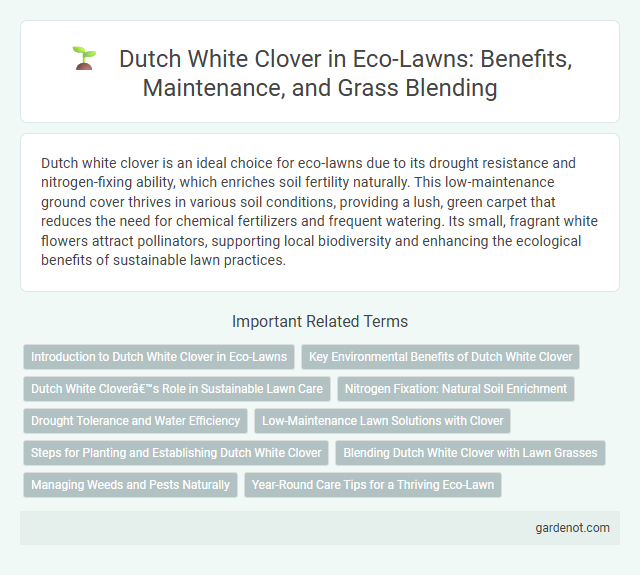Dutch white clover is an ideal choice for eco-lawns due to its drought resistance and nitrogen-fixing ability, which enriches soil fertility naturally. This low-maintenance ground cover thrives in various soil conditions, providing a lush, green carpet that reduces the need for chemical fertilizers and frequent watering. Its small, fragrant white flowers attract pollinators, supporting local biodiversity and enhancing the ecological benefits of sustainable lawn practices.
Introduction to Dutch White Clover in Eco-Lawns
Dutch white clover (Trifolium repens) is a low-growing, nitrogen-fixing legume commonly used in eco-lawns to enhance soil fertility and reduce the need for synthetic fertilizers. Its dense mat of green leaves and small white flowers provides effective ground cover, improving drought resistance and supporting pollinators. Integrating Dutch white clover into eco-lawns promotes sustainable lawn management by decreasing water consumption and increasing biodiversity.
Key Environmental Benefits of Dutch White Clover
Dutch white clover (Trifolium repens) improves soil health by naturally fixing atmospheric nitrogen, reducing the need for synthetic fertilizers and minimizing chemical runoff. Its dense, low-growing foliage enhances soil erosion control while supporting pollinators such as bees, contributing to biodiversity. This perennial cover crop also increases soil organic matter and water retention, promoting sustainable lawn ecosystems.
Dutch White Clover’s Role in Sustainable Lawn Care
Dutch white clover (Trifolium repens) enhances sustainable lawn care by naturally fixing nitrogen in the soil, reducing the need for synthetic fertilizers. Its dense growth suppresses weeds and improves soil structure, promoting healthier turf ecosystems. Incorporating Dutch white clover in eco-lawns supports biodiversity and reduces water consumption, making it an environmentally friendly lawn alternative.
Nitrogen Fixation: Natural Soil Enrichment
Dutch white clover (Trifolium repens) enhances soil fertility through efficient nitrogen fixation, converting atmospheric nitrogen into a form readily available for plant uptake. This natural process reduces the need for synthetic fertilizers, promoting sustainable lawn care and improving overall soil health. Incorporating Dutch white clover in eco-lawns supports long-term soil enrichment and boosts turfgrass growth.
Drought Tolerance and Water Efficiency
Dutch white clover excels in drought tolerance due to its deep root system, which enhances water absorption and retention in eco-lawns. Its natural ability to fix nitrogen reduces the need for frequent irrigation and fertilization, promoting water efficiency. This resilient legume maintains green coverage even in extended dry periods, making it an ideal component for sustainable, low-water turf solutions.
Low-Maintenance Lawn Solutions with Clover
Dutch white clover (Trifolium repens) is an ideal choice for eco-lawns due to its natural nitrogen-fixing ability, which enriches soil fertility and reduces the need for synthetic fertilizers. Its dense, spreading growth habit creates a durable, drought-tolerant ground cover that requires less mowing compared to traditional grass lawns. Incorporating Dutch white clover into low-maintenance lawn solutions promotes biodiversity, improves soil health, and supports pollinators like bees and butterflies.
Steps for Planting and Establishing Dutch White Clover
Dutch white clover (Trifolium repens) thrives in eco-lawns by following specific planting steps to ensure robust growth and sustainability. Begin by preparing well-drained, slightly acidic to neutral soil with a pH between 6.0 and 7.0, removing weeds and loosening the topsoil to enhance root establishment. Sow seeds evenly at a rate of 2 to 4 pounds per 1,000 square feet, lightly rake them into the soil, and maintain consistent moisture during the initial 2 to 3 weeks to promote successful germination and vigorous clover establishment.
Blending Dutch White Clover with Lawn Grasses
Blending Dutch white clover (Trifolium repens) with lawn grasses enhances soil nitrogen levels naturally, reducing the need for synthetic fertilizers and promoting eco-friendly lawn care. Its low-growing, spreading habit complements fine fescues and perennial ryegrass, creating a dense, resilient turf that tolerates drought and foot traffic. This mixture improves biodiversity by supporting pollinators and maintains a vibrant, self-sustaining lawn with minimal maintenance.
Managing Weeds and Pests Naturally
Dutch white clover (Trifolium repens) improves eco-lawn health by fixing nitrogen and creating a dense ground cover that naturally suppresses weeds. Its resilience attracts beneficial insects such as pollinators and predatory beetles, reducing the need for chemical pesticides. Incorporating Dutch white clover in lawns enhances soil fertility while maintaining pest balance through natural ecological processes.
Year-Round Care Tips for a Thriving Eco-Lawn
Dutch white clover (Trifolium repens) enhances eco-lawns by fixing nitrogen, improving soil health, and providing drought resistance. Regular mowing at 3-4 inches encourages dense growth while preserving clover's nitrogen-fixing abilities essential for year-round lawn vigor. Applying a slow-release, phosphorus-rich fertilizer in early spring supports root development, and maintaining consistent moisture through deep, infrequent watering ensures Dutch white clover thrives throughout all seasons.
Dutch white clover Infographic

 gardenot.com
gardenot.com